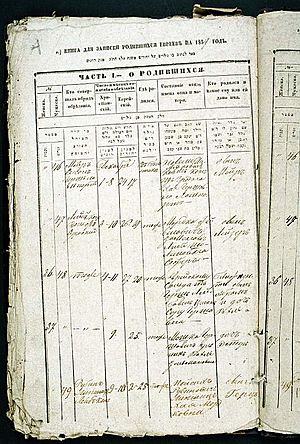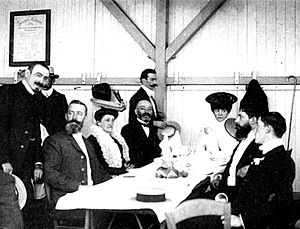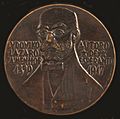L. L. Zamenhof facts for kids
Quick facts for kids
L. L. Zamenhof
|
|
|---|---|
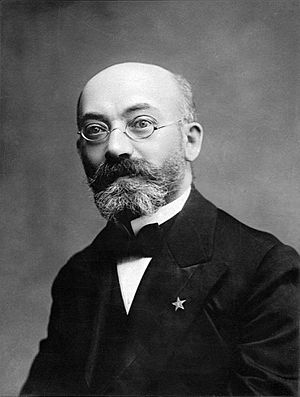
Zamenhof, c. 1895
|
|
| Born |
Leyzer Zamengov
15 December 1859 |
| Died | 14 April 1917 (aged 57) |
| Burial place | Jewish Cemetery, Warsaw |
| Occupation | Eye Doctor |
| Known for | Esperanto |
| Spouse(s) |
Klara Zamenhof
(m. 1887) |
| Children | Adam, Zofia, and Lidia |
| Awards | |
| Writing career | |
| Pen name | Dr. Esperanto |
| Notable works |
|
| Signature | |
L. L. Zamenhof (December 15, 1859 – April 14, 1917) was an eye doctor who lived most of his life in Warsaw. He is famous for creating Esperanto. This is the most widely used made-up international auxiliary language. It was designed to help people from different countries talk to each other.
Zamenhof started working on Esperanto in 1873 when he was still in school. He dreamed of a world without war. He believed a new international language could help achieve this. He thought it would be a fair and neutral way for people to communicate. This language helped create a community that still exists today. This community has grown even after two World Wars and attempts to change the language. Esperanto has grown and changed over time, just like other languages. This happened because its users interacted and got creative.
Because of his work and support for talking between cultures, UNESCO honored Zamenhof in 2017. This was 100 years after he passed away. As of 2019, at least 2 million people speak Esperanto. About 1,000 of them learned it as their first language.
Contents
What's in a Name?
Zamenhof grew up in an area where many languages were spoken. His name is written differently in various languages:
- English: Ludwik Lejzer Zamenhof
- Esperanto: Ludoviko Lazaro Zamenhofo
- French: Louis Lazare Zamenhof
- German: Ludwig "Levi" Lazarus Samenhof
- Hebrew: Eli'ezer Ludwig Zamenhof
- Polish: Ludwik Łazarz Zamenhof
Zamenhof was born into an Ashkenazi Jewish family. His parents gave him the Hebrew name Eliezer. This name is like "Lazarus" in English. Since the area was part of the Russian Empire, his name was recorded as Leyzer Zamengov. This used a Yiddish form of his first name and a Russian version of his last name. His family name, Samenhof, came from German. It later became Zamenhof.
When he was a teenager, he used both the Yiddish Leyzer and the Russian Lazar. At university, he started using the Russian name Lyudovik. This might have been to honor Francis Lodwick, who also worked on a made-up language. Later, to avoid confusion with his doctor brother, he started signing his name "Dr L. L. Zamenhof."
His Life Story
Early Life and Ideas
Zamenhof was born on December 15, 1859. His parents were Mark and Rozalia Zamenhof. They lived in Białystok, a city with many different groups of people. At that time, Białystok was part of the Russian Empire. His parents were Jewish. Zamenhof likely spoke both Yiddish and Russian from birth. His father taught German and French, so Zamenhof learned those too. He also knew Hebrew, Polish, and Belarusian. Later, he studied Latin, Greek, and Aramaic in school. He also learned some English and was interested in Lithuanian and Italian.
Białystok had many groups: Jewish, Polish, Russian, Belarusian, and German people. Zamenhof was sad to see how much these groups argued. He thought that a lack of a common language caused much of the hate. He believed that a shared language could help people from different backgrounds understand each other.
While in high school in Warsaw, Zamenhof tried to create an international language. His first ideas had a complex grammar. But after studying English, he realized the language needed to be simpler. His knowledge of many languages helped him a lot with his project.
By 1878, his language project, called Lingwe uniwersala, was ready. But Zamenhof was too young to publish it. He then went to university to study medicine. He became an eye doctor in 1885. He continued to work on his language project while practicing medicine.
For two years, he tried to find money to publish his language book. Finally, his future wife's father helped him. In 1887, the book was published in Russian. It was called "International language: Introduction and complete textbook." He used the pen name "Doktoro Esperanto," which means "Doctor One Who Hopes." Zamenhof first called his language "Lingvo internacia." But people who learned it started calling it Esperanto, after his pen name. This soon became the official name. For Zamenhof, this language was more than just a tool. It was a way to help people from different cultures live together peacefully.
Work on Jewish Issues
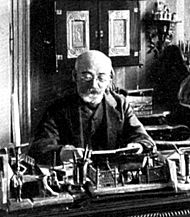
In 1879, Zamenhof wrote the first grammar of Yiddish. Parts of it were published later. The full text was published in 1982. In this work, he looked at Yiddish grammar. He also suggested writing Yiddish using the Latin alphabet.
In 1882, there were attacks on Jewish communities in the Russian Empire. This made Zamenhof join the early Zionist movement, called the Hibbat Zion. He left the movement in 1887. In 1901, he wrote a statement called Hillelism. In it, he said that the Zionist idea could not solve the problems of Jewish people.
In 1914, he turned down an offer to join a new group of Jewish Esperanto speakers. He wrote that he believed "every nationalism offers humanity only the greatest unhappiness." He felt that while nationalism of oppressed people might be understandable, it still caused problems. Zamenhof translated many works into Esperanto, including parts of the Hebrew Bible.
Zamenhof passed away in Warsaw on April 14, 1917. He was buried in the Okopowa Street Jewish Cemetery. The chief rabbi of Warsaw spoke at his funeral. He said that Poland would one day understand how much fame this great man brought to his homeland.
His Family
Zamenhof and his wife, Klara Silbernik, had three children. They had a son, Adam, and two daughters, Zofia and Lidia. Sadly, all three were killed during the Holocaust.
Lidia Zamenhof was very interested in Esperanto. As an adult, she became an Esperanto teacher. She traveled through Europe and America to teach the language. Lidia also became a member of the Baháʼí Faith. This faith teaches that a common world language should be chosen by all nations.
Zamenhof's grandson, Louis-Christophe Zaleski-Zamenhof (Adam's son), lived in France until he passed away in 2019. As of 2020, Louis-Christophe's daughter, Margaret Zaleski-Zamenhof, is active in the Esperanto movement.
His Philosophy
Besides his language work, Zamenhof also shared his ideas about a philosophy called Homaranismo. This term means "humanitism" in English. It was based on the teachings of Hillel the Elder. Zamenhof said that Homaranismo was "the object of my whole life." He would have given up everything for it.
Honors and Things Named After Him
In 1905, Zamenhof received the Légion d'honneur for creating Esperanto. This is a very important award from France. He was nominated 12 times for the Nobel Peace Prize. In 1910, he was nominated by four British Members of Parliament. At the fifth Universala Kongreso de Esperanto in Barcelona, the King of Spain gave Zamenhof an award.
A monument or place connected to Zamenhof or Esperanto is called a Zamenhof-Esperanto object (or ZEO).
A small planet called 1462 Zamenhof is named after him. It was found in 1938. There is also a small planet named after Esperanto itself (1421 Esperanto).
Hundreds of streets, parks, and bridges around the world are named after Zamenhof. In Lithuania, a well-known Zamenhof Street is in Kaunas. He lived there for some time. Other places with Zamenhof names include Poland, the UK, France, Hungary, and Israel. There are also Zamenhof Hills and a Zamenhof Island.
In some Israeli cities, street signs mention Esperanto's creator. They give his birth and death dates. But they use his Jewish name, Eliezer. The Japanese religion Oomoto honors Zamenhof as a deity. They encourage their followers to use Esperanto. A type of lichen (a plant-like organism) is named Zamenhofia after him.
A monument to L. Zamenhof was placed in a courtyard in Odessa, Russia. This was done by an Esperanto-speaking sculptor named Nikolai Vasilyevich Blazhkov. He brought the sculpture there because customs would not let it be sent to an Esperanto Congress.
In Gothenburg, Sweden, a public square is named Esperantoplatsen. In Italy, some streets are named after Esperanto.
In 1959, UNESCO honored Zamenhof for his 100th birthday. In 2015, they decided to support the celebration of 100 years since his death.
His birthday, December 15, is celebrated every year as Zamenhof Day by Esperanto speakers. On December 15, 2009, the green-starred flag of Esperanto was shown on the Google homepage. This was to celebrate Zamenhof's 150th birthday.
The Zamenhof family home and a monument to Zamenhof are part of the Jewish Heritage Trail in Białystok. This trail was opened in 2008. Białystok also has the Ludwik Zamenhof Centre.
In 1960, Esperanto summer schools started in Stoke-on-Trent in the UK. There is a road there called Zamenhof Grove.
The Esperanto Society of New York gathers every December to celebrate Zamenhof Day.
Images for kids
-
Zamenhof on a Lithuanian stamp, 2005
-
Memorial stone in Františkovy Lázně, Czech Republic
-
Mosaic portrait in Prilep, North Macedonia
-
Obverse of medal designed by Polish artist Józef Gosławski
-
On a monument to Esperanto in Den Burg, the Netherlands
See also
 In Spanish: L. L. Zamenhof para niños
In Spanish: L. L. Zamenhof para niños
- Adam Zamenhof
- Zamenhof Day


